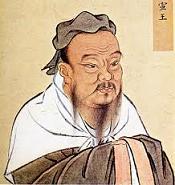
- Confucius -
Eastern philosophy includes the various philosophies of South and East Asia, including Chinese philosophy, Indian philosophy, Japanese philosophy, and Korean philosophy. The great divide between Western and Eastern philosophy is the Himalaya. European and Indian philosophy regard the search for a path away from the ever changing material world as their goal. Chinese philosophy accepts the ever-changing reality as the highest reality and deals with the path or journey of man within this world.
The Indian philosophical tradition
dates back to the composition of the Upanishads in the later Vedic period.
The various schools of
Indian philosophy are identified as orthodox or non-orthodox depending on whether they regard the Veda as an
infallible source of knowledge. There are six schools of orthodox Hindu philosophy
and three heterodox schools. The orthodox are Nyaya,
Vaisesika,
Samkhya,
Rāja yoga,
Mīmāṃsā, and
Vedanta.
The Heterodox are Jain philosophy,
Buddhist, and materialist
Cārvāka
(see also Outlines of Indian Philosophy, M. Hiriyanna, Motilal Banarsidass Publ., 1993 and
Hindu Philosophy, Theos Bernard, Motilal Banarsidass Publ., 1999 and
Dynamic Facets of Indian Thought: Three non-Vedic systems: Cārvāka, Jaina, and Buddha, Anil Kumar Sarkar, Manohar, 1987).
For Indian philosophers (dārśanika) of antiquity, philosophy was a practical necessity that needed to be cultivated to understand how life can best be led.
It was thus customary for them to explain how their ideas and treatises served human ends (puruṣārtha).
Puruṣārtha refers to the four proper goals or aims of a human life. The four puruṣārthas are
Dharma (righteousness, moral values),
Artha (prosperity, economic values),
Kāma (pleasure, love, psychological values), and
Mokṣa (liberation, spiritual values).
Indian philosophy is distinctive in its application
of analytical rigour to metaphysical problems. It goes into very precise detail about the nature of reality, the structure and function of the human psyche,
and how the relationship between the two have important implications for human salvation (moksha). Sages (rishis) centred philosophy on the assumption
that there is a unitary underlying order (Ṛta) in the universe and everything within it. The various schools concentrated on explaining this order
and the metaphysical entity at its source (Brahman). The concept of natural law (Dharma) was the basis for understanding how life on earth should be lived
(see also Brahman: A Comparative Theology, Michael Myers, Routledge, 2013).
An overview of Indian philosophy is given in the section on the Darmic religions
The majority of traditional Chinese philosophy originates in the Spring and Autumn and Warring States eras, during a period known as the Hundred Schools of Thought, which was characterized by significant intellectual and cultural developments. Although much of Chinese philosophy begins in the Warring States period, elements of Chinese philosophy have existed for several thousand years; some can be found in the Yi Jing (the Book of Changes), an ancient compendium of divination, which dates back to at least 672 BCE. It was during the Warring States era that the major philosophies of China, Confucianism, Mohism, Legalism, Daoism arose.

Confucianism is named after its founder Confucius (551-479 BCE),who lived during the Chou dynasty. His writings deal primarily with individual morality and ethics, and the proper exercise of political power by the rulers. Mencius (372-289 BCE) is the most famous Confucian after Confucius himself. The essence of Confucian thought is "benevolence" (Rén) as the core, "courtesy" in the form, focusing on self-cultivation. Confucius devoted most of his teachings to the attainment of social harmony through cultivation of the individual and virtuous government. Man had to be taught (be he a ruler or a commoner) that he was perfectible through education, a moral education able to develop his inner and inborn virtue. Social harmony was achieved when the "Five Relations" were fulfilled ; four of them structure the group and are of a hierarchical nature: Prince - Subject, Elder - Younger, Father - Son, Husband - Wife the fifth relation being among friends. Confucian ethical teachings include the following five values: Rén, Yì, Li, Zhì, Xìn.
The I Ching (E: Book of Changes) is an ancient book which teaches that everything is governed by an "immutable Law of Change". This dualism philosophy centers on the idea that the entire cosmos is composed of equal negative and positive energies. The Yin-Yang is the symbolic representation of this doctrine. The Yin principle symbolizes earthly, passive, negative, female, dark, etc. Yang symbolizes the opposite qualities, such as heavenly, active, positive, male, light, etc. Neither is in itself better or worse than the other, for the two principles have an equal part to play in the totality of existence.
The Thirteen Classics is a term for the group of thirteen classics of Confucian tradition that became the basis for the Imperial Examinations during the Song dynasty. The tradition of a defined group of classics in Chinese culture dates at least to the Warring States period, when the Zhuangzi has Confucius telling Laozi "I have studied the six classics-the Odes, the Documents, the Rites, the Music, the Changes, and the Spring and Autumn Annals".
The Thirteen Confucian Classics are:
易經 (Classic of Changes or I Ching),
書經 (Book of Documents or Shūjīng),
詩經 (Classic of Poetry or Shījīng),
三禮 (The Three Ritual Classics or Sānlĭ),
周禮 (Rites of Zhou or Zhōulĭ),
儀禮 (Ceremonies and Rites or Yĭl;ĭ),
禮記 (Book of Rites or Lĭjĭ),
The Three Commentaries on the Spring and Autumn Annals:
左傳 (The Commentary of Zuo or Zuŏ Zhuàn),
公羊傳 (The Commentary of Gongyang or Gōngyáng Zhuàn),
穀梁傳 (The Commentary of Guliang or Gŭliáng Zhuàn),
論語 (The Analects or Lúnyŭ),
孝經 (Classic of Filial Piety or Xiàojīng),
爾雅 (Erya or Ěryă), a dictionary and encyclopedia,
孟子 (Mencius or Mèngzĭ).
(see also The Encyclopedia of Confucianism: 2-volume Set, Xinzhong Yao, Routledge, 2015, p. 560).
 Confucianism
Confucianism
 Confucianism
Confucianism
 Confucius - (551-479 BC E)
Confucius - (551-479 BC E)
 Analects - Confucius
Analects - Confucius
 Analects - Confucius
Analects - Confucius
 Mencius - (4th Century BCE)
Mencius - (4th Century BCE)
 Xunzi or Hsun Tzu - (310-220 BCE)
Xunzi or Hsun Tzu - (310-220 BCE)
 Hanfeizi or Han Fei Tzu - (c.280-233 BCE)
Hanfeizi or Han Fei Tzu - (c.280-233 BCE)
 Zhu Xi or Chu Hsi - (1130-1200 CE)
Zhu Xi or Chu Hsi - (1130-1200 CE)
 I Ching
I Ching
 I Ching - Key to the I Ching
I Ching - Key to the I Ching
 Chinese Text Project
Chinese Text Project
 Burning of Books - (213 BCE)
Burning of Books - (213 BCE)
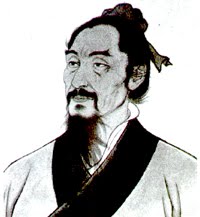
Mohism or Moism was a Chinese philosophy developed by the followers of
Mozi (also referred to as Mo Tzu (Master Mo), Latinized as Micius), (470 BC-ca.391 BCE).
Mohism is best known for the concept of "impartial care" or "universal love" (兼爱; literally "inclusive love").
It evolved at about the same time as Confucianism, Taoism and Legalism, and was one of the four main philosophic schools during the
Spring and Autumn Period (from 770 BC to 480 BCE) and the
Warring States period (479-221 BCE). During that time,
Mohism was seen as a major rival to Confucianism. The Qin dynasty, which united China in 221 BCE,
adopted Legalism as the official government philosophy.
The Han dynasty that followed adopted Confucianism as the official state philosophy,
as did most other successive dynasties. Taoism, and later Buddhism, also played an important part in later Chinese life and thought,
while Mohism all but disappeared as a separate school of thought. Mohist books were later merged into the Taoist canon
(see also History of Chinese Philosophy, Bo Mou, Routledge, 2008, p. 137 and
Introduction to Classical Chinese Philosophy, Bryan W. Van Norden, Hackett Publishing, 2011).
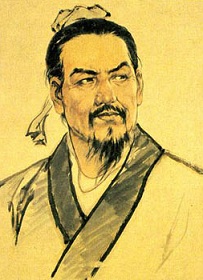
Legalism refers to what westerners would term as the "Realpolitikal"
aspect of administrative Chinese Philosophy,
whose later reformers innovated a rule by law. Building upon the political methodology of the decaying Zhou dynasty,
officials began reforms during the Spring and Autumn Period in-order to support the authority, states and military of the kings.
Reform accelerated with the Warring States period (479-221 BCE),
with the Qin state developing the beginnings of a legal code into an expansive
if undiscriminating institution, generally defining the trend.
Shang Yang (390-338 BCE) was an important Chinese statesman of the
State of Qin during the Warring States period who wrote the Legalist Book of Lord Shang.
The Book of Lord Shang teaches that laws are designed to maintain the stability of the state from the people,
who are innately selfish and ignorant. There is no such thing as objective goodness or virtue; it is obedience that is of paramount importance
(see also Encyclopedia of Chinese Philosophy, Antonio S. Cua, Routledge, 2013 and
The Book of Lord Shang: A Classic of the Chinese School of Law, Yang Shang, Jan Julius Lodewijk Duyvendak, The Lawbook Exchange, Ltd., 1928).
Han Fei (ca. 280-233 BCE) systematized the three central concepts of legalism for practice under the aegis of the figure of a watchful sovereign autocrat:
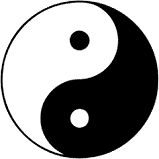
Taoism (Daojiao) is a philosophical school based on texts such as the
Tao Te Ching which is ascribed to Lao Tse - Lao Tzu (6th C. BCE)
(alternately spelled Dào Dé Jïng) and the Zhuangzi. Both the
Tao Te Ching and the
Zhuangzi are in fact composite texts written and rewritten over centuries with
varied input from multiple anonymous writers. Taoism emphasizes living in harmony with the
Tao, meaning "way", "path" or "principle".
The Tao is the intuitive knowing of "life" that of which cannot be grasped full heartedly as just a concept but
known nonetheless as the present living experience of one's everyday being. The underlying principle presented in the Tao Te Ching
is that one should take care of things that are in need of doing, and then move on to the next thing that needs to be done,
without any attachment to the accomplishment. By avoiding any "attachment to the accomplishment" it is meant that one should
not dwell in such things as taking credit for it, accumulating rewards (including material things and power), or spending
time with retelling it in order to get recognition. Along these lines also, one should not bother doing things other than what needs to be done
(see also The Essence of Tao, Alex Anatole, Xlibris Corporation, 2009 and
An Introduction to the Philosophy and Religion of Taoism: Pathways to Immortality, Jeaneane D. Fowler, Sussex Academic Press, 2005).
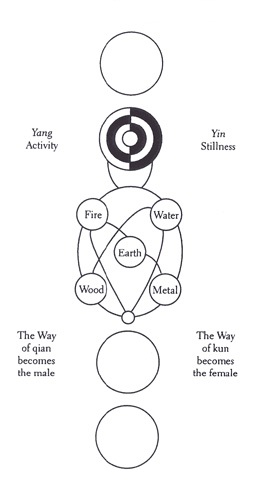
The taijitu (Traditional Chinese:太極圖) or "diagram of supreme ultimate"
is the Chinese symbol for the concept of yin
and yang (Taiji). It is the universal symbol of Taoism and is also often used by non-Taoists to represent the concept of opposites
existing in harmony. The taijitu consists of a rotated pattern inside a circle and represents a dynamic balance between Yin and Yang which is present in the world.
The Song Dynasty philosopher Zhou Dunyi (1017-1073 CE)
wrote the Taijitu shuo 太極圖說 or "Explanation of the Diagram of the Supreme Ultimate",
which became the cornerstone of Neo-Confucianist cosmology. His brief text synthesized aspects of Chinese Buddhism and Taoism with metaphysical discussions in the Yijing.
Zhou's key terms Wuji and Taiji appear in the opening line 無極而太極, which can also be translated
"The Supreme Polarity that is Non-Polar". The explanation of the diagram is as follows:
Non-polar (wuji) and yet Supreme Polarity (taiji)! The Supreme Polarity in activity generates yang; yet at the limit of activity it is still. In stillness it
generates yin; yet at the limit of stillness it is also active. Activity and stillness alternate; each is the basis of the other. In distinguishing yin and
yang, the Two Modes are thereby established. The alternation and combination of yang and yin generate water, fire, wood, metal, and earth.
With these five (phases of) qi harmoniously arranged, the Four Seasons proceed through them. The Five Phases are simply yin and yang; yin and yang are simply
the Supreme Polarity; the Supreme Polarity is fundamentally Non-polar. (Yet) in the generation of the Five Phases, each one has its nature
(see also Dao Companion to Neo-Confucian Philosophy, John Makeham, Springer Science & Business Media, 2010, p. 137 and
A History of Chinese Philosophy, Volume 2, Youlan Feng, Derk Bodde, Princeton University Press, 1983, p. 435).
 Taoism
Taoism
 Lao Tse - Lao Tzu (6th C. BCE)
Lao Tse - Lao Tzu (6th C. BCE)
 Tao Te King - Lao Tse
Tao Te King - Lao Tse
 Tao Te Ching - Lao Tse
Tao Te Ching - Lao Tse
 Zhuangzi or Chuang-Tzu - (369-298 BCE)
Zhuangzi or Chuang-Tzu - (369-298 BCE)
 Works of Zhuangzi - Zhuangzi
Works of Zhuangzi - Zhuangzi

The sole fact that a religion is being mentioned on this page does not mean that the author agrees with its ideas, nor that he is a member of this religion or in any way has a relation with it.
The information contained in this website is for general information purposes only.
The information is provided by me in good faith and while I endeavor to keep the information up to date and correct,
I make no representations or warranties of any kind, express or implied, about the completeness,
accuracy, reliability, suitability or availability with respect to the website or the information,
products, services, or related graphics contained on the website for any purpose.
Any reliance you place on such information is therefore strictly at your own risk.
Any information on this website is provided in good faith but no warranty can be
made for its accuracy. As this is a work in progress, it is still incomplete
and even inaccurate. Although care has been taken in preparing the information
contained in my webpages, I do not and cannot guarantee the accuracy thereof.
Anyone using the information does so at their own risk and shall be deemed
to indemnify me from any and all injury or damage arising from such use.
In no event shall I be liable for any loss or damage including without limitation, indirect or consequential loss or damage, or any loss or damage whatsoever arising from loss of data or profits arising out of, or in connection with, the use of this website.
Through this website you are able to link to other websites which are not under the my control. I have no control over the nature, content and availability of those sites. The inclusion of any links does not necessarily imply a recommendation or endorse the views expressed within them.
Every effort is made to keep the website up and running smoothly. However, I take no responsibility for, and will not be liable for, the website being temporarily unavailable due to technical issues beyond my control.
These webpages of course represent only personal interests, opinions and ideas and
were created without a commercial goal. You may download, display, print and copy, any material at this website,
in unaltered form only, for your personal use or for non-commercial use within
your organisation.
Should these webpages or portions of these webpages be used on any Internet
or World Wide Web page or informational presentation, that a link back to
this website
(and where appropriate back to the source document) be established. Send
a short notice by email when you copy these webpages, or part of it
for your own use.
To the best of my knowledge, all graphics, text and other presentations
not created by me on my webpages are in the public domain and freely available
from various sources on the Internet or elsewhere and/or kindly provided
by the owner.
If you notice something incorrect or have any questions, feel free to send me an email.
The author of this webpage is Peter Van Osta.
Private email: pvosta at gmail dot com